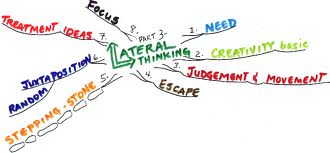by Charles Plant | Jan 31, 2013 | Innovation
 Yesterday, I posed the question: “A woman had two sons who were born on the same hour of the same day of the same year. But they were not twins. How could this be so?”
Yesterday, I posed the question: “A woman had two sons who were born on the same hour of the same day of the same year. But they were not twins. How could this be so?”
I had a few people chime in with an answer but no one got it right the first time. The correct answer is that they weren’t twins but were part of a set of triplets.
Now of course, in life there is no one right answer and I had one very agitated reader who was convinced that her answer was correct and in retrospect it was, so there were two right answers. Her answer: That they were adopted but happened to be born at the same time on the same day, in the same year. Thanks Mom, you’re right.
It was interesting to see how people tried to answer the riddle as it showed a little about how they innovate. Each of you have your own way of meeting creative challenges and each of you uses a slightly different style to solve problems.
- Visioners: Those who envision the ideal future. These people leap to a completely new way of doing something.
- Modifiers: People who refine and optimize what has come before. This is the process of incremental adaptation.
- Explorers: Individuals who discover new and novel possibilities. This is done by applying a solution for one thing to a radically different problem.
- Experimenters: To combine and test many unique combinations. These people try out multiple options.
Which type of innovator are you?
by Charles Plant | Jan 30, 2013 | Innovation
 One of my favourite stories is about slow elevators. As it is told, there was a co-op building in New York where tenants were complaining about slow elevators. Management considered all sorts of solutions including installing additional elevators or speeding up the existing ones until one day someone came up with the idea of putting mirrors beside the elevators so people would have something to do when waiting and then wouldn’t notice the slow service. Great lateral thinking.
One of my favourite stories is about slow elevators. As it is told, there was a co-op building in New York where tenants were complaining about slow elevators. Management considered all sorts of solutions including installing additional elevators or speeding up the existing ones until one day someone came up with the idea of putting mirrors beside the elevators so people would have something to do when waiting and then wouldn’t notice the slow service. Great lateral thinking.
Lateral thinking as defined by Wikipedia is “solving problems through an indirect and creative approach, using reasoning that is not immediately obvious and involving ideas that may not be obtainable by using only traditional step-by-step logic. The term was coined in 1967 by Edward de Bono.”
One of the best ways to innovate is using lateral thinking, so in order to get your innovative juices flowing I want you to solve the following puzzle. I’ll post the answer tomorrow in a reply to the blog in case you don’t get it.
Solve This
A woman had two sons who were born on the same hour of the same day of the same year. But they were not twins. How could this be so?
by Charles Plant | Jan 28, 2013 | Emotional Intelligence
 “There is a great article in the McKinsey Quarterly on cheerfulness. (You may have to register with them to see the article but it is worth it.)
“There is a great article in the McKinsey Quarterly on cheerfulness. (You may have to register with them to see the article but it is worth it.)
They have done studies using Britain’s Royal Navy (of all places) on the effect that cheerfulness has on employees. ” … naval training is predicated on the notion that when two groups with equal resources attempt the same thing, the successful group will be the one whose leaders better understand how to use the softer skills to maintain effort and motivate. For officers leading small teams in constrained quarters, there’s no substitute for cheerfulness and effective storytelling.”
“No one follows a pessimist, and cheerfulness is a choice. It has long been understood to influence happiness at work and therefore productivity. The cheerful leader in any environment broadcasts confidence and capability, and the Royal Navy instinctively understands this. It is the captain, invariably, who sets the mood of a vessel; a gloomy captain means a gloomy ship. And mood travels fast.”
by Charles Plant | Jan 25, 2013 | Innovation
 We celebrate successful innovation but rarely look back at the failures. Since Apple is a great example of successful innovation it is good to remember that not all things they tried were a big success.
We celebrate successful innovation but rarely look back at the failures. Since Apple is a great example of successful innovation it is good to remember that not all things they tried were a big success.
- The Apple QuickTake 100, one of the first commercial digital cameras.
- The Newton, one of the very first smart pen-based computers.
- Cyberdog an OpenDoc-based suite of internet applications.
- Activity Based Computing.
- The Hockey Puck Mouse.
- The Macintosh Portable.
- Pippin, a gaming console and PC.
- G4 Cube.
- ROKR Phone
- OpenDoc, a multi-platform software componentry framework standard.
- The Apple Lisa.
In fact as I sit in my office today, surrounded by Apple products and working on a Mac, I am reminded that the Mac itself almost failed and was saved only by the fortuitous arrival of Adobe’s development of Postscript and Canon’s introduction of low-cost laser printing. Poor targeting, bad marketing, and internal politics all conspired against the Mac and enabled the Microsoft infused IBM PC to become the dominant personal computer.
There are three types of people in the world:
- People that are afraid to fail so they never try anything new
- People that fail at something and then just give up.
- People that fail often when trying new things and go on to become successful because of those failures.
Which one are you?
by Charles Plant | Jan 23, 2013 | Innovation
 I’ve been out talking to a whole bunch of companies in the corporate training space about innovation wondering all the time why they aren’t using more tools such as digital media in extending their training offerings. I got a very interesting insight as to how market leaders think about innovation in talking to one of them.
I’ve been out talking to a whole bunch of companies in the corporate training space about innovation wondering all the time why they aren’t using more tools such as digital media in extending their training offerings. I got a very interesting insight as to how market leaders think about innovation in talking to one of them.
When presented with the idea of using digital media in training, one training company responded that they thought that using digital media now was just too risky and that they couldn’t afford to take such risks. I asked them how this could be when one of their stated company values was innovation. Their response was that they love to innovate but only when all of their customers are asking for something innovative.
The next day I happened to be talking to one of their largest customers about the same subject, using digital media in training. Since this company was clearly interested in the subject I asked them whether they had asked their training supplier for solutions that included digital media.
Their reply: ” Oh we know they can’t supply solutions like this so we don’t even bother talking to them about it.”
To me this was an ‘ah ha’ moment. Big companies aren’t innovating because their customers aren’t demanding it and their customers don’t demand it because they know their suppliers can’t deliver. Perfect disconnect.
by Charles Plant | Jan 21, 2013 | Innovation
 Did you wake up this morning, resolved to do exactly the same things you did last week? I hope not. It’s time to do something new but you better ask the question: Are you being courageous enough to wake up and smell the innovation?
Did you wake up this morning, resolved to do exactly the same things you did last week? I hope not. It’s time to do something new but you better ask the question: Are you being courageous enough to wake up and smell the innovation?
Every morning you need to wake up thinking that everything you know could potentially be wrong. Yes, that’s right, everything you know could be wrong. Scary isn’t it?
But if you don’t think that way, if you think instead that there is something that you know that for sure is absolutely right then you’ll be reluctant to change and fail to innovate in that area. To be able to innovate you must think that everything you know could potentially be wrong and set out to challenge and question all that you know.
 Yesterday, I posed the question: “A woman had two sons who were born on the same hour of the same day of the same year. But they were not twins. How could this be so?”
Yesterday, I posed the question: “A woman had two sons who were born on the same hour of the same day of the same year. But they were not twins. How could this be so?”




